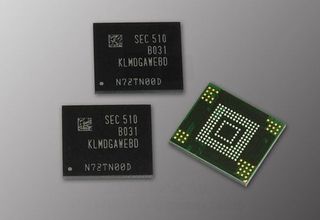Samsung Introduces 128 GB 3-bit eMMC For Mobile Applications
Samsung is hoping to expand the storage capacity of mid-market mobile devices with its speedy new 128 GB eMMC 5.0. In many ways, eMMC packages are simply smaller SSDs that provide data storage for phones, tablets and other mobile devices. eMMC consists of a controller embedded onto a small NAND package, which is perfect for space-constrained mobile devices.
Mobile phones have limited onboard storage, and many are moving away from offering microSD cards for capacity expansion. The reason many companies don't allow microSD cards? It's easy to assume that it's due to the markup. It can cost upwards of $200 to upgrade to a 128 GB iPhone 6 Plus, for instance. This is more than quadruple the current price of the NAND used in SSDs, which can retail as low as 40 cents per GB. It's clear that a low-cost solution is needed to reverse the high-priced trend.
“With the introduction of our value-focused, 3-bit NAND-based eMMC 5.0 line-up, we expect to take the lead in the expansion of high-density mobile storage," said Dr. Jung-Bae Lee, Senior Vice President of Memory Product Planning and Application Engineering Team, Samsung Electronics. “We are continuing to enhance our next-generation embedded mobile memory offerings with improved performance and higher densities to meet increasing customer demand across the mobile industry."

Samsung's 128 GB eMMC is catering to the mid-market by combining eMMC 5.0 and 3-bit NAND. Samsung already offers a 128 GB eMMC UFS 2.0 product for high-end devices with 2-bit NAND, but low cost storage is the key to mid-range devices. 3-bit NAND, more commonly referred to as TLC, offers higher density and a lower price point than the typical 2-bit MLC found in most devices.
3-bit NAND's endurance is considerably lower than 2-bit, but clever engineering has made it useful for a wide range of applications. Apple pioneered using 3-bit NAND for mobile applications in its iPhone 6 Plus, and 3-bit is also used in datacenter and PC applications. It will undoubtedly be the storage of choice for future mobile devices.
There are also faster eMMC 5.1 devices on the market, but eMMC 5.1 (and its UFS 2.0 competitor) will only be found on high-end phones for some time to come. eMMC 5.0 will continue to address the mid- and low-end, and Samsung's product still offers the same sequential speed of 260 MB/s for sequential tasks, such as recording and playing back video. The small packages also offer up to 6,000 random read IOPS, and 5,000 random write IOPS. This weighs in at roughly 10x the speed of a typical external memory card and provides ample speed for multitasking and other intensive workloads.
It will take some time before these new eMMC packages filter down to end user devices, but here's hoping it finally spurs the needed value-centric capacity renaissance in mobile devices.
Stay on the Cutting Edge
Join the experts who read Tom's Hardware for the inside track on enthusiast PC tech news — and have for over 25 years. We'll send breaking news and in-depth reviews of CPUs, GPUs, AI, maker hardware and more straight to your inbox.
Follow us @tomshardware, on Facebook and on Google+.

Paul Alcorn is the Managing Editor: News and Emerging Tech for Tom's Hardware US. He also writes news and reviews on CPUs, storage, and enterprise hardware.
-
jasonelmore So apple's iphone 6 Plus got a 6 month exclusive deal on the NAND it seems. Now other OEM's can buy it.Reply
The same can be said for TSMC's 20nm SOC Process where apple got a 6 month exclusive on that manufacturing node.
It's nice to be apple i guess, but these practices hurt competition. Apple getting to big. I now reflect to the story of the Hobbit and how the dwarves were magnificent craftsman second to no-one. However their love for wealth and gold spawned all sorts of evil that ultimately led to their demise. -
hurnii I thought Apple pulled TLC from production after early reports of constant rebooting after getting a flash update.Reply
Also, with Samsung's still unresolved TLC slowdown issue with their 840 EVO line, I'm not sure how many would trust their TLC eMMC to not slow down read speed after data has been sitting awhile. -
Calvin Huang ReplySo apple's iphone 6 Plus got a 6 month exclusive deal on the NAND it seems. Now other OEM's can buy it.
I doubt Apple had an exclusive on the MLC tech that Samsung is developing. Samsung started producing 128GB 3-bit MLC memory cards in 2013. They had smaller sized cards using 3-bit NAND even before then.
The same can be said for TSMC's 20nm SOC Process where apple got a 6 month exclusive on that manufacturing node.
It's nice to be apple i guess, but these practices hurt competition. Apple getting to big. I now reflect to the story of the Hobbit and how the dwarves were magnificent craftsman second to no-one. However their love for wealth and gold spawned all sorts of evil that ultimately led to their demise.
SanDisk and Toshiba were developing 3-bit NAND on 56nm flash in 2008. This is long before Apple acquired Anobit, which is the MLC tech they adopted and then abandoned.
Anobit had just shrunk their MLC from 40+nm to 25nm in December of 2011 when Apple purchased them. In 2009, Samsung was already producing 20nm MLC. Samsung's new MLC is 10nm. It seems like there's a lot of parallel iterative development going on. Much of it is to address MLC's slower speeds and higher error rate. -
SamQ So Apple is charging $200 to include $44.80 worth of memory (16GB to 128GB @ $0.40/GB). Eh. Sheeple ... er ... I mean Apple customers ... are pretty much used to being fleeced so they won't really care. I mean, really, a $17K watch that cannot stand on it's own? Seriously? I still smile when I think about it.Reply
Most Popular


